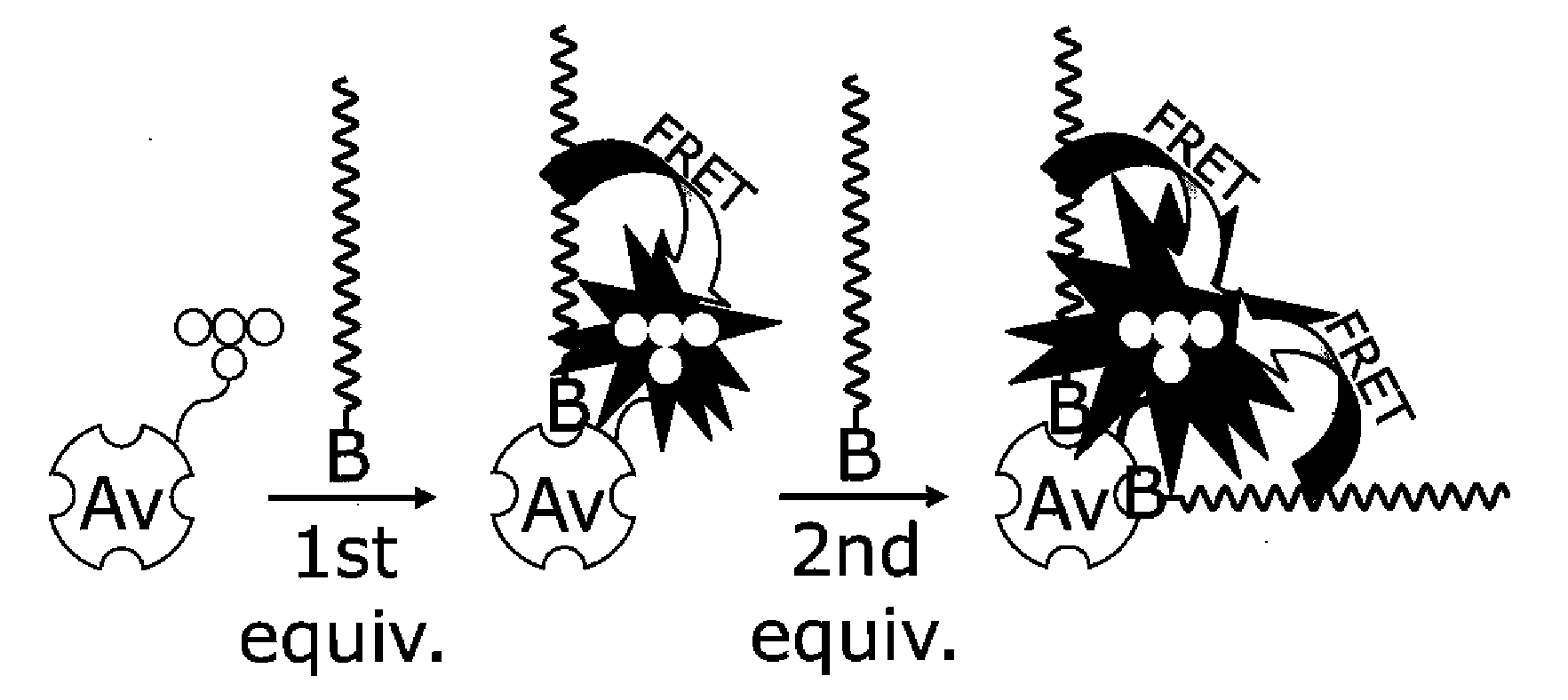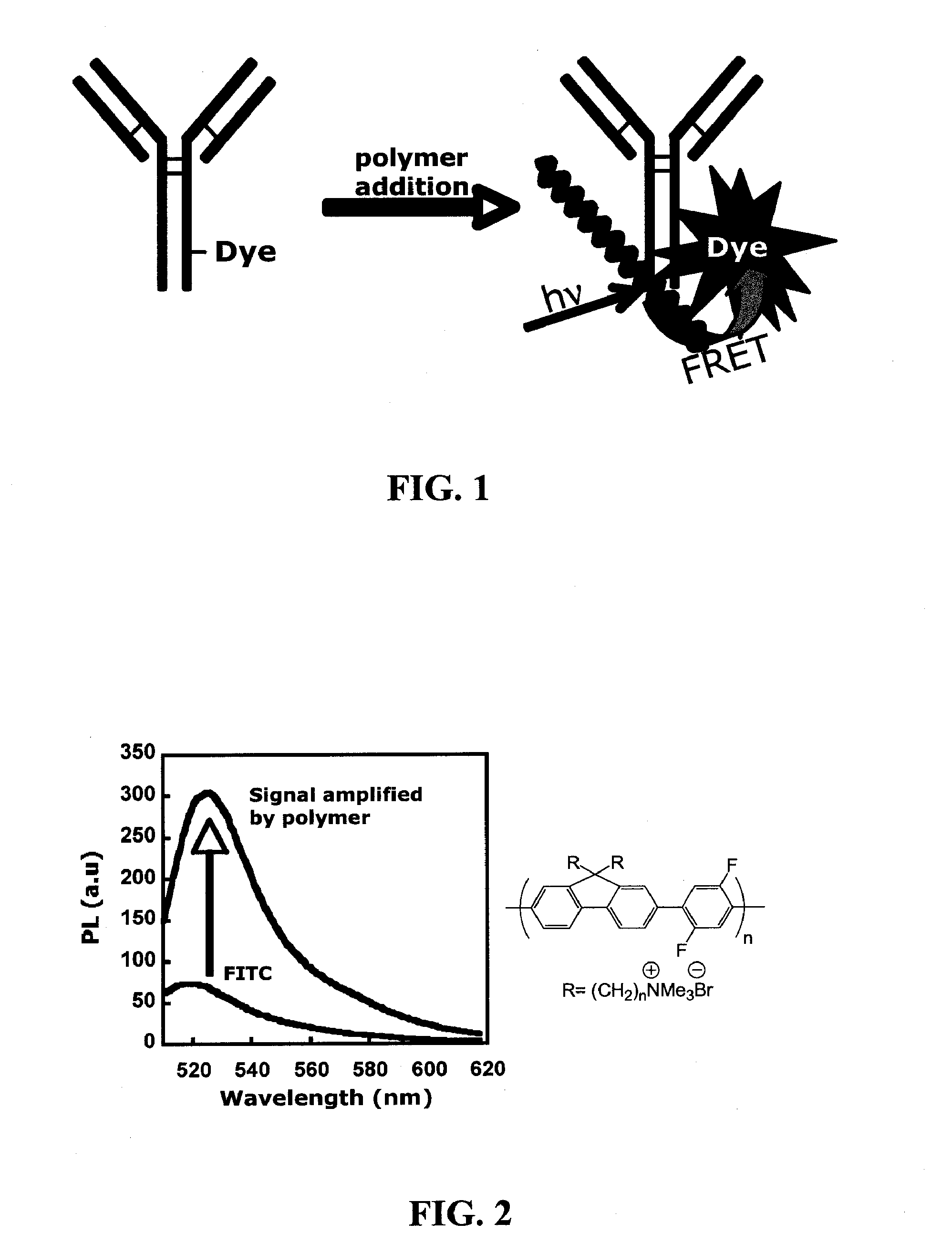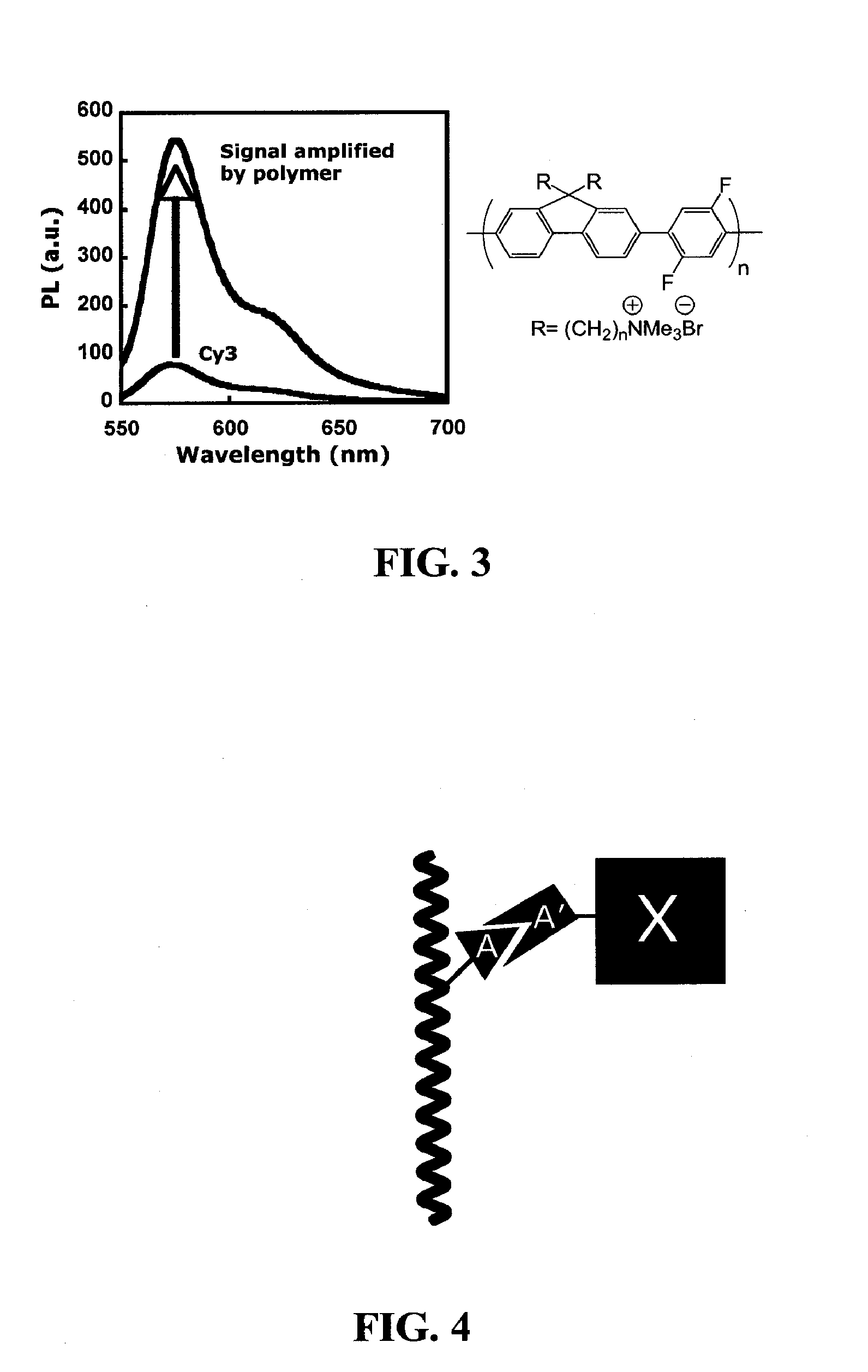Fluorescent Methods and Materials for Directed Biomarker Signal Amplification
a biomarker and signal amplification technology, applied in the direction of material analysis, instruments, solid-state devices, etc., can solve the problem of no such simple method for amplifying targeted materials
- Summary
- Abstract
- Description
- Claims
- Application Information
AI Technical Summary
Benefits of technology
Problems solved by technology
Method used
Image
Examples
example 1
[0251]General protocol for the sandwich ELISA method with polymer-dye conjugated antibody:
[0252]1. Bind the unlabeled antibody to the bottom of each well by adding approximately 50 μL of antibody solution to each well (20 μg / m in PBS) in a 96 wells polyvinylchloride (PVC) microtiter plate. PVC will bind approximately 100 ng / well (300 ng / cm2). The amount of antibody used will depend on the individual assay.
[0253]2. Incubate the plate overnight at 4° C. to allow complete binding.
[0254]3. Wash the wells twice with PBS.
[0255]4. The remaining sites for protein binding on the microtiter plate must be saturated by incubating with blocking buffer. Fill the wells to the top with 3% BSA / PBS with 0.02% sodium azide. Incubate for 2 hrs. to overnight in a humid atmosphere at room temperature.
[0256]5. Wash wells twice with PBS.
[0257]6. Add 50 μL of the antigen (or sample) solution to the wells (the antigen solution should be titrated). All dilutions should be done in the blocking buffer (3% BSA / P...
example 2
General Protocol for Microarray Labeling with Polymer-Dye Conjugated Antibody
[0266]1. Prepare total RNA or mRNA.
[0267]2. Use T7-oligo(dT) primer to perform one-cycle or two-cycle cDNA synthesis.
[0268]3. Cleanup of double stranded cDNA.
[0269]4. Use IVT (in vitro transcription) amplification kit to incorporate biotin-labeled ribonucleotide into cRNA.
[0270]5. Fragmentation of cRNA.
[0271]6. Hybridize cRNA fragments on chip.
[0272]7. Wash off residual cRNA and stain the chip with streptavidin-polymer-dye conjugate (Example B or D)
[0273]8. Wash off residual reagents on chip.
[0274]9. Scan microarray.
[0275]In the regular practice of microarray methodology, an integration of biotin-labeled nucleotides into the cRNA sequences is the means of sequestering the streptavidin phycoerythrin conjugate and biotinylated anti-streptavidin antibody for amplified signal reporting. Due to the manufacture complexity of streptavidin phycoerythrin conjugate, the batch-to-batch variation is significant. Theref...
example 3
Synthesis of Cationic Conjugated Polymer with an Amine Functional Group, CA001
[0277]
[0278]1-(4′-Phthalimidobutoxy)-3,5-dibromobenzene: 3,5-dibromophenol (970 mg, 3.85 mmol) was recrystallized from hexanes. After removal of solvent, N-(4-bromobutyl)phthalimide (1.38 g, 4.89 mmol), K2CO3 (1.88 g, 13.6 mmol), 18-crown-6 (53 mg, 0.20 mmol), and acetone (20 mL) were added. This was refluxed for 1 hour, and then poured into 100 mL of water. The aqueous layer was extracted with dichloromethane (4×30 mL). The organic layers were combined, washed with water, saturated NaHCO3, and brine, then dried over MgSO4 and filtered. Removal of solvent yielded a white solid, which was purified by column chromatography (4:1 hexanes:CH2Cl2) followed by recrystallization in hexanes to yield colorless needles (650 mg, 87%). 1H NMR (CDCl3): 7.860 (m, 2H); 7.733 (m, 2H); 7.220 (t, J=1.6 Hz, 1H); 6.964 (d, J=2.0 Hz, 2H); 3.962 (t, J=6.0 Hz, 2H); 3.770 (t, J=6.6 Hz, 2H); 1.846 (m, 4H).
[0279]Poly[(2,7-{9,9-bis(6...
PUM
| Property | Measurement | Unit |
|---|---|---|
| temperatures | aaaaa | aaaaa |
| temperatures | aaaaa | aaaaa |
| temperatures | aaaaa | aaaaa |
Abstract
Description
Claims
Application Information
 Login to View More
Login to View More - R&D
- Intellectual Property
- Life Sciences
- Materials
- Tech Scout
- Unparalleled Data Quality
- Higher Quality Content
- 60% Fewer Hallucinations
Browse by: Latest US Patents, China's latest patents, Technical Efficacy Thesaurus, Application Domain, Technology Topic, Popular Technical Reports.
© 2025 PatSnap. All rights reserved.Legal|Privacy policy|Modern Slavery Act Transparency Statement|Sitemap|About US| Contact US: help@patsnap.com



